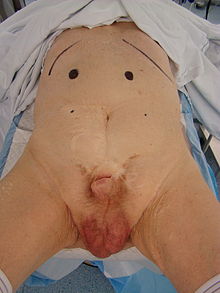Bladder exstrophy
| Classification according to ICD-10 | |
|---|---|
| Q64.1 | Urinary bladder exstrophy |
| ICD-10 online (WHO version 2019) | |
The bladder exstrophy (from ancient Greek ἐκ ek , German 'outwards, out' and στροφή strophē , German 'turn' ) is a rare congenital malformation from the so-called bladder exstrophy-epispadias complex . It occurs in approximately one in 40,000 to 50,000 live births. Boys are affected roughly twice as often as girls. The diagnosis includes a spectrum of malformations of the lower abdominal wall, the urinary bladder , the anterior pelvic ring and the external genitals . The first written description of the bladder cleft was made by Johannes Schenck von Grafenberg in 1597.
Pathogenesis
The reason for the development of a bladder exstrophy is a malformation of the lower abdominal wall, which leads to a rupture , so that the urinary bladder is exposed to the outside. You can see both ureter openings from which urine is constantly dripping.
Malformation spectrum
The typical manifestation of the bladder exstrophy-epispadias complex is the bladder exstrophy with the urinary bladder exposed to the outside, a gaping symphysis with an outwardly turned gait and - in boys - an epispadia (split of the urethra along the back of the penis) or - in girls - a clitoris divided into two with a split urethra.
In addition, isolated epispadias as well as so-called cloacal exstrophies - in which the rectum is also affected in addition to the symptoms of bladder exstrophy - occur. Both forms of the bladder exstrophy-epispadias complex are less common than the bladder exstrophy itself.
treatment
Treatment consists of surgical correction of the defect . Nowadays, attempts are generally made to close the urinary bladder and, if necessary, to increase its capacity. If this does not lead to the expected success, an “artificial” bladder replacement must be considered in order not to endanger the kidney function and to ensure sufficient urinary continence . A urine reservoir is usually formed from a piece of intestine that was previously separated from the rest of the intestine. This reservoir can then be emptied in various ways. A cosmetic correction of the external genitals should be carried out in an often later procedure . The aim of any therapy should be to maintain kidney function , which is not impaired by the malformation from birth, while at the same time ensuring adequate urinary control and continence. Improving sexual functionality also plays an important role.
The transtrigonal ureterosigmoidostomy introduced by Karel Maydl (1853–1903) in 1892 was the first to solve the problem of urinary incontinence.
Complications
Surgical therapy for urinary bladder exstrophy belongs in the hands of centers with sufficient experience of the rare clinical picture. If the operation is unsuccessful, there is a risk of lifelong incontinence, a lack of bladder capacity, and sexual dysfunction.
forecast
Even with successful surgical treatment, patients may be faced with the following long-term problems:
- Urinary incontinence
- Urinary retention in the kidney
- recurrent inflammation of the urogenital tract
- sexual dysfunction
Web links
- Guidelines of the German Society for Pediatric Surgery on the epispadias-exstrophy complex
- Self-help group for bladder exstrophy / Epispadie eV
Individual evidence
- ↑ Bladder exstrophy-epispadias complex. In: Orphanet (Rare Disease Database).
- ^ WH Rösch, AK Ebert: History of bladder exstrophy treatment in Germany in Der Urologe , issue 46, number 12, December 2007.
